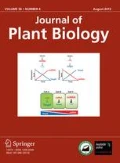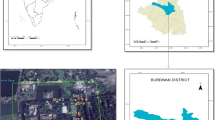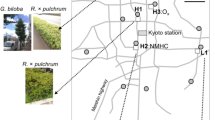Abstract
We investigated the net photosynthetic rates and antioxidative enzyme activity inPlatanus occidentalis trees growing on two separate streets in Seoul, and representing different degrees of air pollution. In general, concentrations of SO2, NO2, and PM10 decreased from May to September. The photosynthetic rate was reduced significantly on the street with higher levels of pollution. Moreover, activities of two antioxidative enzymes, ascorbate peroxidase and glutathione reductase, were greater in May along the more polluted street. These data suggest thatP. occidentalis growing in highly polluted environments may increase their antioxidant enzyme activity to compensate for and to minimize the damage from this stress.
Similar content being viewed by others
Literature Cited
Beckett KP, Freer-Smith PH, Tayor G (2000) Participate pollution capture by urban trees: Effect of species and wind speed. Global Change Biol6: 995–1003
Bielenberg DG, Lynch JP, Pell EJ (2002) Nitrogen dynamics during Cyinduced accelerated senescence in hybrid poplar. Plant Cell Environ25: 501–512
Chung AY (2005) Korea Times. Ozone concentration in Seoul. http://times.hankooki.com/
D’Haese D, Vandermeiren K, Asard H, Horemans N (2005) Other factors than apoplastic ascorbate contribute to the differential ozone tolerance of two clones ofTrifolium repens L. Plant Cell Environ28: 623–632
Elkarmi A, Eideh RA (2006) Allometry ofUrtical urens in polluted and unpolluted habitats. J Plant Biol49: 9–15
Fornazier RF, Ferreira RR, Vitoria AP, Molina SMG, Lea PJ, Azevedo RA (2002) Effects of cadmium on antioxidant enzyme activities in sugar cane. Biol Plant45: 91–97
Grantz DA, Silva V, Toyota M, Ott M (2003) Ozone increases root respiration but decreases leaf CO2 assimilation in cotton and melon. J Exp Bot54: 2375–2384
Gravano E, Giulietti V, Desotgiu R, Bussotti F, Grossoni P, Gerosa G, Tani C (2003) Foliar response of anAilanthus altissima clone in two sites with different levels of ozone pollution. Environ Pollut121: 137–146
Hurst AC, Grams TEE, Ratajczak R (2004) Effects of salinity, high irradiance, ozone, and ethylene on mode of photosynthesis, oxidative stress and oxidative damage in the C3/CAM intermediate plantMesembryanthemum crystallinum L. Plant Cell Environ27: 187–197
Kangasjarvi J, Talvinen J, Utriainen M, Karjalainen R (1994) Plant defense systems induced by ozone. Plant Cell Environ17: 783–794
Karnosky DF, Pregitzer KS, Zak DR, Kubiske ME, Hendrey GR, Weinstein D, Nosal M, Percy KE (2005) Scaling ozone responses of forest trees to the ecosystem level in a changing climate. Plant Cell Environ28: 965–981
Koch JR, Creelman RA, Eshita SM, Seskar M, Mullet JE, Davis KR (2000) Ozone sensitivity in hybrid poplar is correlated with insensitivity to both salicylic acid and jasmonic acid: The role of programmed cell death in lesion formation. Plant Physiol123:487–496
Koch JR, Scherzer AJ, Eshita SM, Davis KR (1998) Ozone sensitivity in hybrid poplar is correlated with a lack of defense-gene activation. Plant Physiol118: 1243–1252
Lascano HR, Casano LM, Melchiorre MN, Trippi VS (2001) Biochemical and molecular characterization of wheat chloroplastic glutathione reductase. Biol Plant44: 509–516
Lawson T, Craigon J, Black CR, Colls JJ, Landon G, Weyers JDB (2002) Impacts of elevated CO2 and O3 on gas exchange parameters and epidermal characteristics in potato (Solarium tuberosum L). J Exp Bot53: 737–746
Meloni DA, Oliva MA, Martinez CA, Cambraia J (2003) Photosynthesis and activity of Superoxide dismutase, peroxidase and glutathione reductase in cotton under salt stress. Environ Exp Bot49: 69–76
Mooney HA, Küppers M, Koch G, Gorham J, Chu C, Winner WE (1988) Compensating effects to growth of carbon partitioning changes in response to SO2-induced photosynthetic reduction in radish. Oecologia75: 502–506
Nakano Y, Asada K (1981) Hydrogen peroxidase is scavenged by ascorbate-specific peroxidases in spinach chloroplast. Plant Cell Physiol22: 867–880
Neto ADA, Prisco JT, Enesa-Filho J, Abreu CEB, Gomes-Filho E (2006) Effects of salt stress on antioxidative enzymes and lipid peroxidation in leaves and roots of salt-tolerant and salt-sensitive maize genotypes. Environ Exp Bot56: 87–94
Parida AK, Das AB, Mohanty P (2004) Investigations on the antioxidative defense responses to NaCI stress in a mangrove,Bruguiera parviflora: Differential regulations of isoforms of some antioxidative enzymes. Plant Growth Regul42: 213–226
Perrings C, Katharina DS, Touza J, Williamson M (2005) How to manage biological invasions under globalization. Trends Ecol Evol20: 212–215
Reich PB, Lassoie JP, Amundson RG (1983) Reduction in growth of hybrid poplar following field exposure to low levels of O5 and SO2. Can J Bot62: 2835–2841
Reich PB, Schoettle AW, Stroo HF, Troiano J, Amundson RG (1984) Effects of O3, SO2 and acidic rain on mycorrhizal infection in northern red oak seedlings. Can J Bot63: 2049–2055
Robinson MF, Heath J, Mansfield TA (1998) Disturbances in stomatal behavior caused by air pollutants. J Exp Bot49: 461–469
Samuelson L, Kelly JM (2000) Scaling ozone effects from seedlings to forest trees. New Phytol149: 21–41
Vollenweider P, Günthardt-Goerg MS (2005) Diagnosis of abiotic and biotic stress factors using the visible symptoms in foliage. Environ Pollut137: 455–465
Vollenweider P, Ottiger M, Günthardt-Goerg MS (2003) Validation of leaf ozone symptoms in natural vegetation using microscopical methods. Environ Pollut124: 101–118
Winner WE (1994) Mechanistic analysis of plant responses to air pollution. Ecol Appl4: 651–661
Wohlgemuth H, Mittelstrass K, Kschieschan S, Bender J, Weigel HJ, Overmyer K, Kangasjarvi J, Sandermann H, Langebartels C (2002) Activation of an oxidative burst is a general feature of sensitive plants exposed to the air pollutant ozone. Plant Cell Environ25: 717–726
Author information
Authors and Affiliations
Corresponding author
Rights and permissions
About this article
Cite this article
Woo, S.Y., Je, S.M. Photosynthetic rates and antioxidant enzyme activity ofPlatanus occidentalis growing under two levels of air pollution along the streets of Seoul. J. Plant Biol. 49, 315–319 (2006). https://doi.org/10.1007/BF03031162
Received:
Accepted:
Issue Date:
DOI: https://doi.org/10.1007/BF03031162




